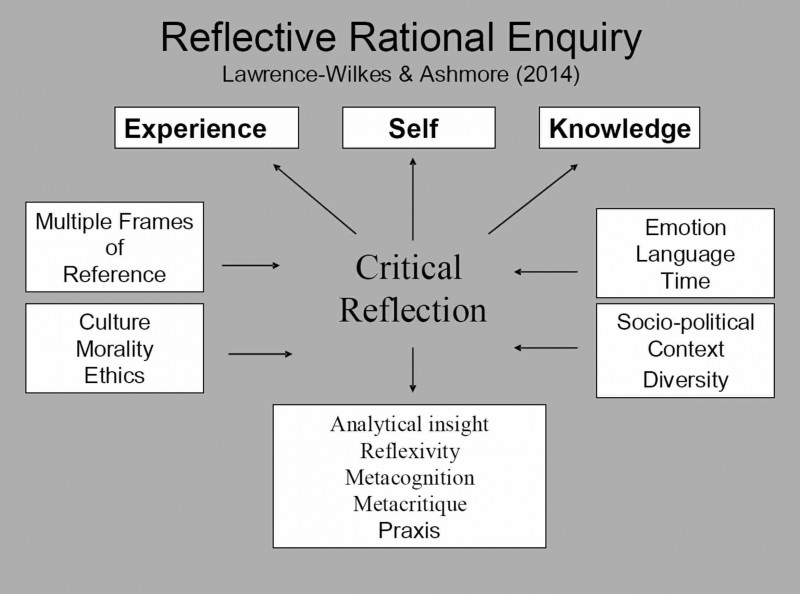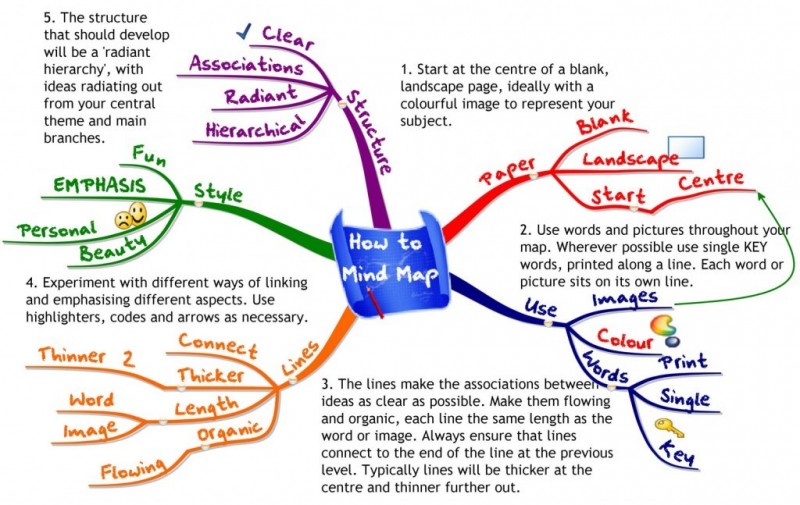Reflection maps emphasize the connections created during the EL activity, often creating a new understanding between theory and practice (see Diagram 5). The associative nature of reflection mapping encourages students to approach their memory of the EL activity more creatively, yielding unexpected feelings or interpretations. While still directed by the facilitator, these reflection exercises allow the students more control over their interpretation of the EL activity. Reflection maps are usually visual devices and can range from simple Venn diagrams to multi-page, scaffolding e-portfolios.
Diagram 5
To promote learning, reflection mapping assignments must be focused by the instructor. Without clear goals and boundaries, the maps are likely to create confusion rather than clarify connections. Providing students with a Kolb-type reflection cycle and specific questions in each of the four quadrants can be used to emphasize the connection between the experience and a particular learning goal. Using Tony Buzan’s mind mapping technique is another way to visualize the learning from an EL activity (see Diagram 6).
(reproduced from http://www.mind-mapping.co.uk/ )
Diagram 6
E-portfolios provide an ongoing personal learning environment where the student can collect and layer descriptive and reflective documents over a single or a series of EL activities. Connected webpages which link the experience to course learning goals through text and visuals provide successively deeper reflections. As a collection device, e-portfolios can encompass multiple reflection techniques by including directed writings, blogs, feedback, and visualization of the student’s learning. The standard organization of e-portfolios mimics the DEAL model for critical reflection by recommending 3 parts for the portfolio: a present tense description as the experience happens, a summative interpretation of the experience, and a directive “next steps” section which articulates the lessons learned. As with the other reflection mapping activities, it is through the creation of the final product that substantive reflection occurs.
Applicability: Any EL activity could benefit from a reflection mapping exercise, however experiences with creative or tactile components are particularly well-suited to this approach. Group reflections can also benefit from this method. Because of their time-consuming nature, e-portfolios are best when used with an EL activity which lasts an entire term. Ideally, students would build their e-portfolio over the course of their college career, so an e-portfolio reflection assignment is simply another facet of the student’s ongoing e-portfolio project.
Sample Assignments and Assessment:
Community Mural - Creating a mural enables students to express feelings and learning from the service experience and also allows for a creative collective statement about aspects of an issue facing a community. Murals are excellent final projects for the end of a course, and can be developed in concept and final product over the entire length of the course. Students can use various sources (magazines, newspapers, other art materials) to build their mural. Faculty can use class time or out-of-class time for this work.
Faculty need to define well the criteria for evaluation of content, yet allow freedom for means of expression. Display final projects at a community site or on campus. In addition, students may want to create a community mural that can be permanently displayed at an agency or community site.
Career Development e-Portfolio – The University of Puget Sound’s Career Awareness course (CRDV 203) required students to build an e-portfolio to house their coursework and reflect upon their learning and progress over the semester. Specific pages were created by the students: “Career Assessment”, “Career Exploration”, and “Career Action.” These pages were reviewed by peers and the professor over the course of the semester, with the final product serving as the final assignment. Like all e-portfolios it served two purposes: as a visual representation of the student’s production over the semester and as a process of reflection. E-portfolios allow students to apply their creativity and energy to a product they can carry with them well past the individual course. (Jennifer Allen-Ayers, CRDV203A syllabus, Spring 2016, University of Puget Sound)
References
Buzan, Tony. (2012). Modern Mind Mapping for Smarter Thinking. UK: Pro-active Press.
Lawrence-Wilkes, Linda and Lyn Ashmore. (2014). The Reflective Practitioner in Professional Education. London: Palgrave-McMillan.
Pellissippi State Community College. Sample Reflection Activities. http://www.pstcc.edu/service-learning/_files/pdf/ReflectionActivities.pdf

